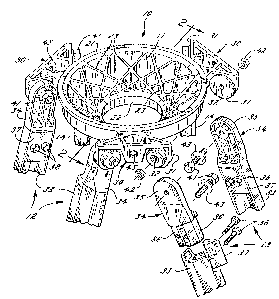Une partie des informations de ce site Web a été fournie par des sources externes. Le gouvernement du Canada n'assume aucune responsabilité concernant la précision, l'actualité ou la fiabilité des informations fournies par les sources externes. Les utilisateurs qui désirent employer cette information devraient consulter directement la source des informations. Le contenu fourni par les sources externes n'est pas assujetti aux exigences sur les langues officielles, la protection des renseignements personnels et l'accessibilité.
L'apparition de différences dans le texte et l'image des Revendications et de l'Abrégé dépend du moment auquel le document est publié. Les textes des Revendications et de l'Abrégé sont affichés :
| (12) Brevet: | (11) CA 1317925 |
|---|---|
| (21) Numéro de la demande: | 1317925 |
| (54) Titre français: | EMBASSE POUR INSTRUMENT |
| (54) Titre anglais: | INSTRUMENT SUPPORT SOCKET |
| Statut: | Périmé et au-delà du délai pour l’annulation |
| (51) Classification internationale des brevets (CIB): |
|
|---|---|
| (72) Inventeurs : |
|
| (73) Titulaires : |
|
| (71) Demandeurs : |
|
| (74) Agent: | MACRAE & CO. |
| (74) Co-agent: | |
| (45) Délivré: | 1993-05-18 |
| (22) Date de dépôt: | 1988-07-26 |
| Licence disponible: | S.O. |
| Cédé au domaine public: | S.O. |
| (25) Langue des documents déposés: | Anglais |
| Traité de coopération en matière de brevets (PCT): | Non |
|---|
| (30) Données de priorité de la demande: | S.O. |
|---|
Abstract
An instrument support socket for adjustably
receiving a member of a support plate having an outer
spherical surface wherein the socket, formed
integrally, is an outer and upper ring portion
connected to an inner and lower ring portion by
intercrossed ribs with upper surfaces of the ring
portions and ribs defining segments of a conical
surface capable of cooperating with spherical
surfaces of differing radii. The socket forms a
tripod head by having lugs on the upper ring portion
that extend out and embrace the elements of the
tripod legs so that the tripod legs are mounted from
the outside of their respective elements.
Note : Les revendications sont présentées dans la langue officielle dans laquelle elles ont été soumises.
Note : Les descriptions sont présentées dans la langue officielle dans laquelle elles ont été soumises.

2024-08-01 : Dans le cadre de la transition vers les Brevets de nouvelle génération (BNG), la base de données sur les brevets canadiens (BDBC) contient désormais un Historique d'événement plus détaillé, qui reproduit le Journal des événements de notre nouvelle solution interne.
Veuillez noter que les événements débutant par « Inactive : » se réfèrent à des événements qui ne sont plus utilisés dans notre nouvelle solution interne.
Pour une meilleure compréhension de l'état de la demande ou brevet qui figure sur cette page, la rubrique Mise en garde , et les descriptions de Brevet , Historique d'événement , Taxes périodiques et Historique des paiements devraient être consultées.
| Description | Date |
|---|---|
| Inactive : Demande ad hoc documentée | 1996-05-18 |
| Le délai pour l'annulation est expiré | 1995-11-20 |
| Lettre envoyée | 1995-05-18 |
| Accordé par délivrance | 1993-05-18 |
Il n'y a pas d'historique d'abandonnement
Les titulaires actuels et antérieures au dossier sont affichés en ordre alphabétique.
| Titulaires actuels au dossier |
|---|
| Q-CO INDUSTRIES, INC. |
| O'CONNOR ENGINEERING LABORATORIES |
| Titulaires antérieures au dossier |
|---|
| JOEL W. JOHNSON |